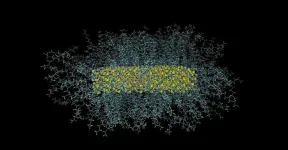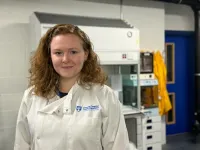(Press-News.org) From brighter TV screens to better medical diagnostics and more efficient solar panels, new Curtin-led research has discovered how to make more molecules stick to the surface of tiny nanocrystals, in a breakthrough that could lead to improvements in everyday technology.
Lead author Associate Professor Guohua Jia from Curtin’s School of Molecular and Life Sciences, said the study investigated how the shape of zinc sulfide nanocrystals affected how well molecules, known as ligands, stick to their surface.
“Ligands, play an important role in controlling the behaviour and performance of zinc sulfide nanocrystals in various important technologies,” Associate Professor Jia said.
“In a discovery that could open new possibilities for developing smarter, more advanced devices, our study found flatter, more even particles called nanoplatelets allow more ligands to attach tightly, compared to other shapes like nanodots and nanorods.
“By adjusting the shape of these particles, we were able to control how they interacted with their surroundings and make them more efficient in various applications.
“From brighter LED lights and screens to more efficient solar panels and more detailed medical imaging, the ability to control particle shapes could revolutionise product efficiency and performance.”
Associate Professor Jia said the discovery could enhance the performance of devices known as optoelectronics, which either produce light or use light to perform their functions.
“Optoelectronics are important in many modern technologies, including telecommunications, medical devices and energy production,” Associate Professor Jia said.
“The ability to efficiently manipulate light and electricity is central to the advancement of faster, more efficient and more compact electronic systems.
“This includes LEDs, which convert electricity into light and are used in everything from light bulbs to TV screens as well as solar cells that convert light into electrical energy, powering devices using sunlight.
“Other devices that could be advanced by this discovery include photodetectors that sense light and convert it into an electrical signal, such as in cameras and sensors, plus laser diodes used in fibre-optic communication that convert electrical signals into light for data transmission.”
The full study titled ‘Deciphering surface ligand density of colloidal semiconductor nanocrystals: Shape matters’ will be published in the Journal of the American Chemical Society and can be found online here: https://doi.org/10.1021/jacs.4c09592.
From brighter TV screens to better medical diagnostics and more efficient solar panels, new Curtin-led research has discovered how to make more molecules stick to the surface of tiny nanocrystals, in a breakthrough that could lead to improvements in everyday technology.
Lead author Associate Professor Guohua Jia from Curtin’s School of Molecular and Life Sciences, said the study investigated how the shape of zinc sulfide nanocrystals affected how well molecules, known as ligands, stick to their surface.
“Ligands, play an important role in controlling the behaviour and performance of zinc sulfide nanocrystals in various important technologies,” Associate Professor Jia said.
“In a discovery that could open new possibilities for developing smarter, more advanced devices, our study found flatter, more even particles called nanoplatelets allow more ligands to attach tightly, compared to other shapes like nanodots and nanorods.
“By adjusting the shape of these particles, we were able to control how they interacted with their surroundings and make them more efficient in various applications.
“From brighter LED lights and screens to more efficient solar panels and more detailed medical imaging, the ability to control particle shapes could revolutionise product efficiency and performance.”
Associate Professor Jia said the discovery could enhance the performance of devices known as optoelectronics, which either produce light or use light to perform their functions.
“Optoelectronics are important in many modern technologies, including telecommunications, medical devices and energy production,” Associate Professor Jia said.
“The ability to efficiently manipulate light and electricity is central to the advancement of faster, more efficient and more compact electronic systems.
“This includes LEDs, which convert electricity into light and are used in everything from light bulbs to TV screens as well as solar cells that convert light into electrical energy, powering devices using sunlight.
“Other devices that could be advanced by this discovery include photodetectors that sense light and convert it into an electrical signal, such as in cameras and sensors, plus laser diodes used in fibre-optic communication that convert electrical signals into light for data transmission.”
The full study titled ‘Deciphering surface ligand density of colloidal semiconductor nanocrystals: Shape matters’ will be published in the Journal of the American Chemical Society and can be found online here: https://doi.org/10.1021/jacs.4c09592.
END
(Monday 14 October 2024, Vienna, Austria) Researchers have unveiled a novel approach to tackle obesity by targeting fat absorption in the small intestine. The cutting-edge nanoparticle system, engineered to deliver therapeutic molecules directly to the digestive tract, has shown significant potential to prevent diet-induced obesity.1,2
Presented today at UEG Week 2024, the study focuses on an enzyme called Sterol O-acyltransferase 2 (SOAT2), which plays a critical role in fat absorpsion in the small intestine.3,4 By inhibiting this enzyme in the small intestine, the study offers a promising therapeutic approach to reduce fat absorption ...
(Monday 14 October 2024, Vienna, Austria) Groundbreaking research presented today at UEG Week 2024 reveals a promising new treatment strategy for type 2 diabetes (T2D) that could significantly reduce or even eliminate the need for insulin therapy.1
This innovative approach, which combines a novel procedure known as ReCET (Re-Cellularization via Electroporation Therapy) with semaglutide, resulted in the elimination of insulin therapy for 86% of patients.
Globally, T2D affects 422 million people, with obesity recognised as a significant ...
Copenhagen, Denmark: Severely injured children who are brought to an emergency medical department by their parents or carers are often not seen as quickly as those who arrive at hospital via ambulance, according to findings presented at the European Emergency Medicine Congress today (Monday). [1]
The study’s researchers identified three key trauma features that should prompt doctors to review these patients immediately and potentially prioritise their treatment: boggy swelling to the head, abdominal bruising, and thigh swelling or deformity.
The study was carried out in an inner-city ...
Copenhagen, Denmark: International experts in emergency medicine have warned that climate change is likely to have a severe impact on emergency services around the world. Despite this, few countries have assessed the scale of the impact or have a plan to deal with it.
In a special session at the European Emergency Medicine Congress today (Sunday), Luis Garcia Castrillo, a professor in emergency medicine, now retired, at the Hospital Marqués de Valdecilla, Santander, Spain, described how he and colleagues from EUSEM’s Emergency Medicine Day working group had asked 42 focus groups, consisting of experts in emergency medicine, prehospital care ...
(13 October 2024, Vienna, Austria) Cutting-edge research has uncovered how chronic stress disrupts the balance of gut microbiota to speed up the progression of colorectal cancer (CRC), opening new avenues for CRC prevention and treatment.1
By eliminating certain gut bacteria and inducing stress, researchers were able to conclude a relationship between stress and gut microbiota in the progression of CRC, identifying a particular bacterial species as a potential therapeutic target.
Presenting the study at UEG Week 2024, lead researcher Dr Qing Li explained, “In our study, we used an antibiotic ...
Researchers at the Federal University of São Carlos (UFSCar), the State University of Campinas (UNICAMP) and the University of São Paulo (USP) in Brazil have characterized for the first time a class of proteins present in the parasite Leishmania infantum and involved in regulating its cell cycle. In an article published in PLOS Pathogens, they describe potential pharmaceutical targets for the treatment of visceral leishmaniasis. Existing therapeutic strategies are considered insufficiently effective.
In eukaryotic organisms, which have cells with a defined nucleus and include all plants and animals, the ubiquitin-proteasome system (UPS) ...
With the help of deep learning, University of California, Berkeley, scientists have leveraged citizen science data from the app iNaturalist to create the highest resolution maps yet of plant distributions throughout California.
iNaturalist is a widely-used cellphone app, originally developed by UC Berkeley students, that allows people to upload photos and the location data of plants, animals or any other life they encounter and then crowdsource their identity. The app currently has more than 8 million users worldwide who collectively have uploaded more than 200 million observations.
The researchers used a ...
Respiratory syncytial virus (RSV) is the leading cause of hospitalization in young children due to respiratory complications such as bronchiolitis and pneumonia. Yet little is understood about why some children develop only mild symptoms while others develop severe disease. To better understand what happens in these cases, clinician-scientists from Brigham and Women’s Hospital, a founding member of the Mass General Brigham healthcare system, and Boston Children’s Hospital analyzed samples from patients’ airways and ...
SAN ANTONIO, Oct. 11, 2024 – David Gius, MD, PhD, professor in the Department of Radiation Oncology and assistant dean of research at The University of Texas Health Science Center at San Antonio (UT Health San Antonio), was named this year’s recipient of the prestigious American Society for Radiation Oncology (ASTRO) Career Recognition Mentorship Award.
Gius is associate cancer center director for translational research at Mays Cancer Center at UT Health San Antonio. He is among three awardees receiving this recognition. The award honors individuals who have made significant contributions to mentorship ...
Hitting the bull’s eye to target ‘undruggable’ diseases – researchers reveal new levels of detail in targeted protein degradation
Targeted protein degradation has opened up a new field of drug discovery with potential to treat previously ‘undruggable’ diseases
Dundee researchers have revealed new levels of details of how protein degraders work
The work means new drugs can be much more accurately targeted at the molecular level, creating and hitting a metaphorical ...




